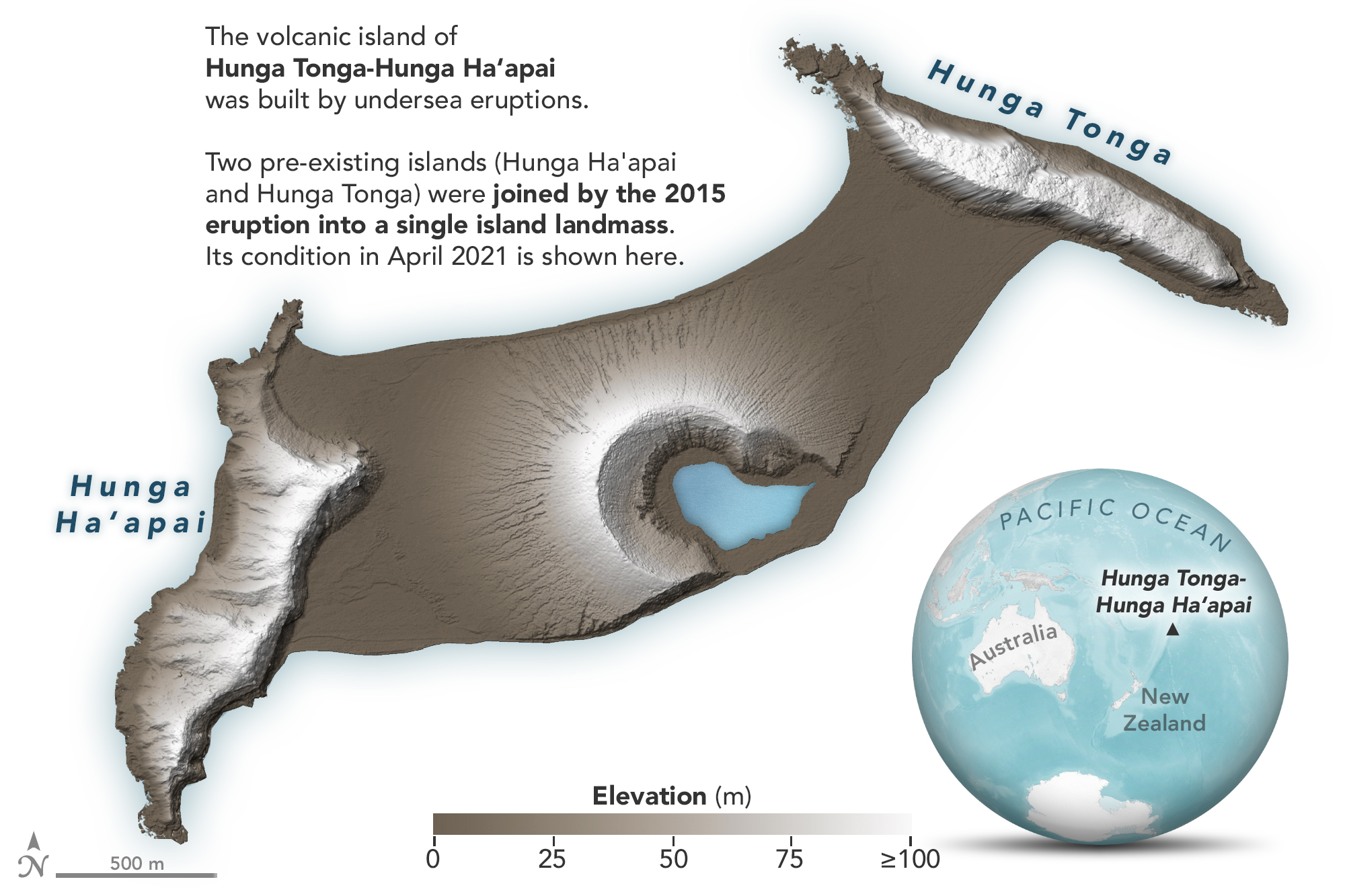Ahmedabad
(Head Office)Address : 506, 3rd EYE THREE (III), Opp. Induben Khakhrawala, Girish Cold Drink Cross Road, CG Road, Navrangpura, Ahmedabad, 380009.
Mobile : 8469231587 / 9586028957
Telephone : 079-40098991
E-mail: dics.upsc@gmail.com

Hunga Tonga-Hunga Ha'apai Volcano
News: Recently, scientists believe that one of the reason why the world is experiencing unprecedented rise in temperatures is due to an underwater volcanic eruption of Hunga Tonga-Hunga Ha'apai in the South Pacific in 2022.
About Hunga Tonga-Hunga Ha’apai Volcano:
• It is a submarine volcano located in the South Pacific, specifically in the Kermadec-Tonga Ridge. This ridge is formed by the convergent boundary where the Pacific Plate is subducted by the Indo-Australian Plate, forming a long volcanic and island chain.
• It is an undersea Volcano consisting of two small uninhabited islands, Hunga-Ha’apai and Hunga-Tonga.
How does it impact World’s temperature?
• Generally, massive volcanic eruptions usually reduce temperatures as they spit out vast amounts of sulfur dioxide, which form sulfate aerosols that can reflect sunlight back into space and cool Earth’s surface temporarily, generally referred as Sun dimming. However, the Tonga eruption had another effect because it occurred underwater.
• The eruption of Hunga Tonga-Hunga Ha'apai in 2022 produced a plume 58 km high, and produced the biggest atmospheric explosion ever recorded.
• The Hunga Tonga-Hunga Ha'apai eruption is peculiar because, in addition to causing the largest increase in stratospheric aerosol in decades, it also injected vast amounts of water vapor into the stratosphere. Water vapor is a natural greenhouse gas that absorbs solar radiation and traps heat in the atmosphere.
• The aerosol and water vapor impact the climate system in opposing ways, but several studies have proposed that, due to its larger and more persistent water vapor plume, the eruption could have a temporary net surface warming effect.
How have volcanic eruptions impacted global climate in the past?
• In the past 2,500 years, there have been about eight even bigger eruptions, according to the Intergovernmental Panel on Climate Change (IPCC), Among them, Tambora in Indonesia in 1815 led to a 'year without a summer' - with failed harvests from France to the United States.
• The climactic eruption of Mount Pinatubo (Philippines) on June 15, 1991, injected a 20-million ton sulfur dioxide cloud into the stratosphere at an altitude of more than 20 miles. It caused what is believed to be the largest aerosol disturbance of the stratosphere in the twentieth century and cooled the Earth’s surface for three years following the eruption.

Address : 506, 3rd EYE THREE (III), Opp. Induben Khakhrawala, Girish Cold Drink Cross Road, CG Road, Navrangpura, Ahmedabad, 380009.
Mobile : 8469231587 / 9586028957
Telephone : 079-40098991
E-mail: dics.upsc@gmail.com
Address: A-306, The Landmark, Urjanagar-1, Opp. Spicy Street, Kudasan – Por Road, Kudasan, Gandhinagar – 382421
Mobile : 9723832444 / 9723932444
E-mail: dics.gnagar@gmail.com
Address: 2nd Floor, 9 Shivali Society, L&T Circle, opp. Ratri Bazar, Karelibaugh, Vadodara, 390018
Mobile : 9725692037 / 9725692054
E-mail: dics.vadodara@gmail.com
Address: 403, Raj Victoria, Opp. Pal Walkway, Near Galaxy Circle, Pal, Surat-394510
Mobile : 8401031583 / 8401031587
E-mail: dics.surat@gmail.com
Address: 303,305 K 158 Complex Above Magson, Sindhubhavan Road Ahmedabad-380059
Mobile : 9974751177 / 8469231587
E-mail: dicssbr@gmail.com
Address: 57/17, 2nd Floor, Old Rajinder Nagar Market, Bada Bazaar Marg, Delhi-60
Mobile : 9104830862 / 9104830865
E-mail: dics.newdelhi@gmail.com